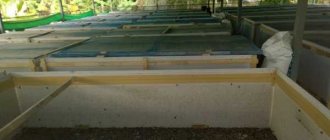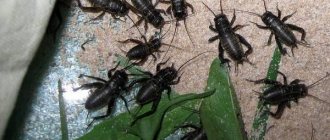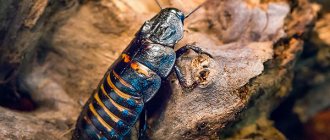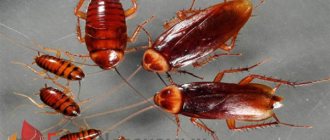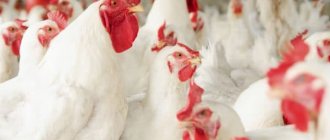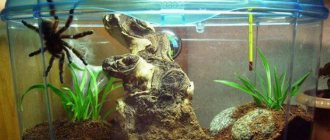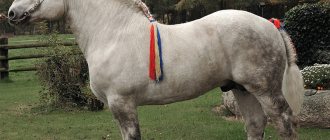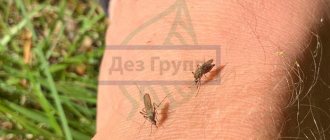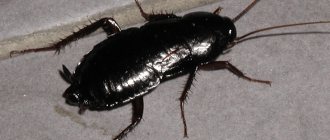Exotic lovers often have unusual animals at home, for example, Madagascar cockroaches. These representatives of the class of insects attract owners with their behavioral characteristics, exotic appearance, as well as unpretentiousness in maintenance and care. In addition, cockroaches of this species are absolutely safe for people prone to allergies.
In the article we will look at the features of keeping Madagascar cockroaches, what conditions are suitable for them, what insects eat, how long they live and how they reproduce.
Madagascar cockroach - content
It is not difficult to keep them - Madagascar hissing cockroaches are omnivores and happily eat various fruits, vegetables and herbs. For a small colony, about 30 individuals, you only need a terrarium measuring 20x30x40cm. Any tightly closing container will do - you should always remember that our friend can hold and move perfectly on any, even completely smooth glass surface thanks to the soft pads on the legs. Of course, there is no need to completely seal them; there should still be air access.
But if, despite all the precautions, he still manages to get out of the terrarium, he will not cause much trouble - although this creature is scary in appearance, it has a non-aggressive, calm character and is absolutely harmless both to humans and to its fellows , including kids. However, in rare cases this insect can cause allergies.
Access to water is very important for cockroaches; without it, they can die. But you can’t just put a bowl of water, like decorative rabbits or guinea pigs; insects can drown in it, especially the younger generation. The ideal option would be a special drinking bowl: damp, water-soaked material, such as foam rubber. In order for it to always perform this function, it must be periodically moistened. You can make a container with water yourself. To do this, you need to take a small bowl and fill it with foam rubber, then moisten it with water. Cockroaches will run on wet foam and drink water from it.
The Madagascar hissing cockroach has several features that make it stand out from countless other species and make it funny and distinctive. It has no wings at all, so it looks more like a beetle. The female does not lay eggs, but gives birth to already living offspring in the form of larvae, which quite deftly crawl around the terrarium and its walls. After 4 months, the larvae become young, agile cockroaches. Just make sure to keep an eye on it! As a rule, there are from 10 to 50 babies.
Cockroaches in a terrarium may have bedding, the same as for rodents. Sawdust, paper, rags, coconut substrate, pebbles, clay and sand are suitable. You can use special pressed sawdust that is sold for cat litter. You can add the height of the litter layer at your discretion, usually about 2 centimeters. But in principle, bedding is not necessary, they will run without problems without it, and this will not affect their health in any way. If there is bedding, try to avoid softwood sawdust; cedar sawdust is especially not recommended. If there are mites in the litter, it needs to be replaced. A good bedding is coconut substrate. How often to change the bedding depends on the number of cockroaches and the size of the cage. On average, the litter should be changed once a month.
Cockroaches are nocturnal animals; they do not really like light, so they need shelter. Rolls of toilet paper or paper towels work best. You can build various structures from them. The easiest way is to use several cardboard egg cartons as shelter. Build a small house from several of these stands; this will also increase the area of the cage, which is essential if there are a lot of cockroaches.
When keeping Madagascar cockroaches, try to maintain a temperature of 25-30 °C. If your room is less than 20 degrees, then your pets will not die, but they are unlikely to reproduce and will become passive. In the terrarium, it is necessary to maintain a relative air humidity of ~65%, but violating this requirement does not significantly harm the cockroaches. To maintain sufficient humidity, spray the inside of the house with water from a spray bottle several times a week.
Is it worth getting such a pet?
Whether to keep a Madagascar cockroach in the house or not is a rhetorical question.
If a hobby doesn’t bother others, then why not. However, it is worth thinking before getting such an original pet, weighing the pros and cons.
Everyone is in favor
The Madagascar hissing cockroach will not cause much trouble at home. Keeping it is easier than, say, fish in an aquarium or canaries in a cage.
- they do not fly, unlike other types of cockroaches;
- do not emit an unpleasant odor;
- it’s easy to hide a tray with insects so as not to shock guests;
- they reproduce easily, which is important if insects are bred to feed the inhabitants of a home terrarium - snakes, iguanas;
- do not get dirty in the house;
- they do not bite and cannot harm a person;
- You can sell quality specimens to cockroach race organizers.
Holiday organizing agencies in Ukraine offer such an attraction; this is a new type of business.
While it is not very widespread, it is not cheap, and therefore consumers are people with above-average incomes. This entertainment is often arranged for guests of corporate events.
With this attribute, in particular, the day of March 8 is celebrated, because the running season is precisely this spring month; in winter, insects are not active enough.
There are many countries in the world where cockroach racing is a common form of entertainment for the lower classes of the population, and this will not necessarily be a Madagascar.
In addition to those listed above, there are 2 more types of use of cockroaches:
- for food;
- like living decoration in the form of necklaces.
Everyone is against
There are no specific contraindications. But if there are family members in the house for whom the proximity to these insects does not bring pleasure, to put it mildly, then the answer is unequivocal - no. In addition, pet cockroaches have been proven to cause asthma.
Whether this applies to Madagascans is unknown. But to avoid troubles, if there are people with allergies in the house, it is better to avoid keeping Madagascar cockroaches.
Conditions of detention
Madagascar cockroaches do very well in captivity. This is evidenced by at least such a fact as their life expectancy. In nature, insects live no more than one and a half years, and at home - up to 2-3 or even 5 years. Old cockroaches have a slightly lighter color, which distinguishes them from young cockroaches.
Cockroaches should be kept in spacious terrariums. The volume of the terrarium should be such that there is at least 1 cubic decimeter of space per cockroach. To maintain a colony of cockroaches consisting of 30 individuals, a fish aquarium that holds 30 liters of water is suitable. At the bottom of the terrarium, lay bedding up to 2 cm thick. Coconut substrate is well suited for bedding. Even scraps of paper, rags, and sawdust will do, but only from deciduous trees. The litter needs to be changed every month.
Pets
When red or black cockroaches appear in an apartment, you can notice how dogs or cats begin to hunt for them. Most do it for fun, pleasure, and bring it to show the owner.
Who else is eating:
- If there is a lizard living at home, you can let it out for a walk; it also feeds on domestic cockroaches.
- Spiders that live in every house hunt for insects. They weave a web and wait for one of them to fall into the net. The spider releases its poison with acid inside the body, which paralyzes and digests the insides, which later becomes an excellent meal. A dried cockroach from the inside becomes a bait for its other relatives.
- The domestic hedgehog also feeds on small insects. He hunts for them in corners and catches colonies.
As you can see, the list of those who like to eat unpleasant insects is quite extensive. Therefore, at home you can successfully fight them; to do this, it is enough to have pets.
Unusual types of cockroaches
In addition to insects that parasitize human homes, there are quite a large number of exotic species. Terrarists enjoy breeding huge cockroaches and even make friends with them.
Chess cockroach (Therea petiveriana)
It lives in southern India and is nocturnal. During the daytime, it hides in fallen leaves, under trees, and buries itself under the roots of plants. It reaches 2.5 centimeters in length. The name was given due to its unusual coloring - white spots on a black background.
The chess cockroach in no way resembles domestic insects. They are kept in a plastic box with latches. A special soil is required, consisting of loose soil, peat, and coconut substrate.
Chess cockroaches are fed carrots, pears, and bread. The presence of rotting residues in the box is not allowed.
Madagascar hissing cockroach (Gromphadorhia portentosa)
Reaches a length of nine centimeters. In nature, it lives for 1–2 years; in artificial conditions and with good care, the age can reach five years. When frightened or in need of protection, the Madagascar cockroach begins to hiss.
For breeding, a small terrarium with a lid that should not fit tightly is required. At the same time, the gap must be narrow enough so that the insect cannot crawl out - there are special suction cups on the cockroach’s legs that enable the insect to move along an absolutely smooth surface.
Herbaceous parts of plants and fruits are given as food.
Death's head cockroach (Blaberus cranifer)
Reaches a length of 5.5 centimeters. It got its name because of the characteristic spot on the back, reminiscent of a skull. During the day it hides in the leaves and goes out hunting in the evening and at night. Feeds on small insects.
When kept in a terrarium, it is necessary to add dog food to the food. If this is not done, the cockroaches begin to eat each other.
Requires careful handling. When frightened, it can bite or be pricked by thorns
To imagine what exotic species look like, it is best to look at what cockroaches look like in a photo. Modern technologies make it possible to obtain high-quality images, and you can see the smallest details in the structure of insects.
Subtleties of content
Keeping Madagascar cockroaches is not very difficult or troublesome. They do not crap in the home, do not have a characteristic odor, do not harm human health, are quite calm, and lead a lazy lifestyle.
Easily reproduced in captivity
What you need to know
Those people who want to become the owner of an exotic animal are interested in the question: what special requirements do Madagascar cockroaches need, what is the content and nutritional base of insects? Before purchasing this creature, you need to have information about their lifestyle.
Gestation, reproduction
The female cockroach is a very caring mother. Pregnant, she does not lay eggs, but carries them constantly in the so-called genital pouch. There are about 30-40 eggs in one ootheca (cocoon).
Nymphs are always close to the female
From time to time, the female either protrudes or hides the ootheca, regulating the temperature. Larvae (nymphs) hatch after 3 months. The nymphs are translucent, only their black eyes stand out. However, after 2-3 hours they become dark brown. Nymphs eat the ootheca and the remains of their shell. After 6-10 months, the larvae turn into adults, going through 6-8 molts. The mother does not leave them, gathering them around her and protecting them from danger. However, many do not live to reach adulthood. Only 80-85% of those who survived are suitable for further breeding.
Lifestyle
These creatures are very shy. During daylight hours they sit in shelters, and at dusk they crawl out to find food. In their natural habitat, they settle under snags and inside rotten stumps. In other words, where the rich smell of wood is felt.
As we already know, the homeland of these creatures is the tropics. Therefore, they like warm and humid climates. The optimal air temperature for their normal functioning is 27 degrees.
The optimal humidity level is 65%.
Conditions for keeping an exotic guest
Under indoor conditions, these beetles are placed in
Convenient to keep in an insectarium
, maintaining the desired air temperature inside. The walls of the insectarium are periodically, up to several times a week, sprayed with hot water using a spray bottle. A prerequisite regarding the temperature of the water is necessary for the formation of fog, which cockroaches really like.
Basically, keeping cockroaches at home does not require any special effort.
The volume of the insectarium is determined by taking into account the desired number of individuals that it is decided to purchase. On average, 1 liter of container is required per individual
Various shelters are built in containers and wood shavings are scattered. The house itself is installed in a place where direct sunlight does not reach.
To prevent insects from getting out of the insectarium, especially the younger generation, its walls are lubricated with Vaseline. In addition, the top of the house is covered with mesh, which allows air to pass through well.
The bottom of the dwelling is covered with a mixture of soil with peat and sand. Change the litter at least once a month. The layer should be about 30 mm. Cardboard or paper is placed on it. This layer is needed to dispose of excess moisture and excrement. It would be a good idea to place branches and pieces of bark so that cockroaches can crawl on them.
When living conditions have been created, all that remains is to ensure that the family is well-fed.
Nutritional base of insects
The question: what to feed a Madagascar guest most often arises among beginners. These insects are not picky about food. Their diet consists of plant foods. You can feed cockroaches vegetables and fruits. You can offer them jam, porridge, boiled eggs. They will not refuse a salad made from celery, dandelion, and soft cabbage.
There must be standing water. The detail that should be taken into account is that the water should be in shallow containers so that the young individuals do not drown in them. You can soak a piece of foam rubber with water.
One more nuance: you should ensure that you get enough calcium into your diet. To do this, place a piece of chalk or medications containing calcium.
Benefit or harm from an exotic neighborhood?
This Madagascar cockroach does not pose any harm or danger to humans. Even if he crawls out of his home, he himself will suffer. Because external conditions outside the house that are not suitable for its normal life will lead to the death of the insect.
These creatures do not bite people or pets. But there is no benefit from them either.
You can purchase them at the poultry market or via the Internet. However, it is worth knowing that they can only live for 3-4 days in a packaged package.
https://youtube.com/watch?v=UbDPNw-usFI
After molting
A nymph without a shell is very vulnerable. It should not be picked up. It is recommended to take photos of your pet from a terrarium. The metamorphoses that the insect undergoes took a lot of energy from it. It takes 2-3 hours to restore pigmentation and hardness of the shell.
The body, which was long, becomes flat and wide. The rest of the insects that are in the terrarium do not interfere with the rest of the molted nymph. They don't pay attention to her.
In order for the strength of the new shell to be high, the shell is quickly restored, the cockroach begins to gnaw on its chitinous shell, which it has just shed.
Madagascar cockroach after molting
In this way, he replenishes his body with protein. Mineral salts and vitamins. Usually he doesn't finish it completely. The remains are picked up by other insects in the container.
After the nymph has taken on its usual appearance, it goes to the feeder. During this period, she is given protein food, gammarus for fish. Juicy vegetables and fruits are also placed in the feeder. They are a source of fiber, vitamins and mineral salts.
After mass molting of insects, the temperature and humidity in the terrarium can be reduced. Usually it is brought to room temperature.
Insect lifestyle
Insects are shy. In the wild, they can be found in the jungles of the island of Madagascar. During the day they hide in the forest floor, and at night they crawl to the surface and eat various rotting animal and plant debris. These insects do not bite, so they cannot cause any harm to humans.
To escape from various predators, insects use so-called guerrilla tactics: they try to reveal themselves with movements as little as possible, and if a predator finds them, the cockroaches begin to press themselves to the ground with all their might.
They are distinguished by their ability to hiss loudly and sharply. This is where the name of the insects comes from. This hiss can repel some types of snakes. Such hissing often frightens even experienced terrarium keepers; it is produced by insects very sharply.
To hiss, adult cockroaches use special organs called spiracles located on the surface of the body. The insect simply needs to sharply bend its body and contract its lungs to emit a hissing sound. This hissing in some species resembles a whistle.
Female Madagascar cockroaches begin to hiss only when they sense approaching danger. With this sound they also scare away their enemies. Males may also hiss when courting females and when fighting with other males.
There is a very interesting fact - in an insect colony, a clear hierarchy is established among the males. During a fight, males clash their horns. As a result, the weakest male falls and turns over on his back, thereby demonstrating his defeat. Many males have other injuries on their bodies that were received during fights.
How long do Madagascar cockroaches live? In their natural habitat, the average lifespan of Madagascar cockroaches is 1-1.5 years. In captivity, these insects can live up to 3 years. Despite this, there have been cases where pets lived for 5-6 years. Towards the end of their lives, Madagascar cockroaches usually begin to lighten in color.
How do Madagascars reproduce?
Madagascar hissing cockroaches are viviparous. After the male secretion enters, the eggs in the female's abdomen unite, forming a complete form (chamber) - an ooteca. It is located inside the female until the larvae are ready to emerge. The female has one specific ability: sometimes she pushes out the ootheca through the anus, which allows the offspring to be ventilated.
The offspring develop within 50-70 days. The period of time depends on the temperature in the place where the female finds herself. If it's cold enough, the eggs will take longer to hatch.
The larvae do not emerge immediately. First, they end up in the female’s abdomen, from where they are pushed into the surrounding space along with ootheca particles. This will be their first food immediately after birth. The offspring begins to eat the ootheca, and after that the color of the nymphs’ bodies changes – it becomes darker. Newborn larvae are several millimeters long, but already resemble an adult.
During one specific “pregnancy”, the female “Madagascar” gives birth to 20-25 larvae. For several days after being pushed out of the mother’s abdomen, they remain next to her, and then crawl away in different directions. Cockroach larvae tend to molt several times until they become sexually mature. The chitinous cover is not adapted for growth, therefore, as the individual increases in size, it cracks in half, allowing the insect to seem to emerge from the old shell. A shed cockroach has a soft and light coat, which hardens very quickly when the nymph eats the shed layer. As a result, the insect becomes dark brown in color.
A cockroach can molt 6 times; depending on the temperature, all stages of changing the chitinous shell can be completed in 6-12 months.
In captivity, individuals can live for about 4-5 years. Of course, if the owner tries to create ideal conditions for the inhabitants.
Insects can be bred in ordinary apartments and houses not only as decorative and unusual pets, but also as food for other reptiles. Thus, the Madagascar hissing cockroach will be a good meal for lizards, amphibians, spiders, and snakes. In fact, this is an ideal food - it is natural, non-toxic, safe for other creatures, and it is easy to breed these insects.
Description of a hissing cockroach
The insect lives in the tropics of the island of Madagascar, which determined the name - Madagascar cockroach (Gromphadorhina portentosa). Insects are not able to move outside the island on their own. This means that they can only be purposefully removed. It happens that giant cockroaches crawl inside food boxes, in this way they can move to the other end of the continent.
External signs
The pet is quite large: up to 9 cm long, weighing up to 60 g. At the development stage until the adult individual is fully formed, insects have no wings. Considering the large size, it is logical that the chitinous covers should be sufficiently durable. Madagascar cockroaches have reliable protection on their back and abdomen. The color of the shell varies: from a light brown shade to a darker, black color.
Segments are visible on the cephalothorax of insects. If at the developmental stage most representatives of other species have similar characteristics to the larvae, then the Madagascar hissing cockroaches are formed differently - the larva bears little resemblance to the adult.
The female can be distinguished from the male by a number of characteristics: she has no protruding growths on the sides; the mustache is intact; The sizes are a little larger.
Insects have whiskers for orientation. They are used as antennas that help find food, orient insects in space, and help find a mate. Males often have damaged whiskers as they compete for the right to possess the female. This feature can also be used to determine age: the more frayed the mustache is, the older the cockroach.
Insect larvae are light-colored, like representatives of other families. Almost immediately after birth, when exposed to sunlight, the color changes to darker. At the stage of development to an adult, the larva sheds its shell several times.
Unlike some of their fellow cockroaches, large Madagascar cockroaches are not prone to cannibalism. In extreme cases, when the body of such insects lacks calcium, they attempt to bite the shell of their fellow insects, which leads to the death of an individual with damaged chitinous cover.
Lifestyle and eating habits
These cockroaches are distinguished by their timidity. They hide in the forest floor during the day and crawl out at night. At night, the insects Gromphadorhina portentosa obtain food for themselves. They can crawl into trees. Favorite habitats: stumps, snags, crevices of old rotting trees. The main condition when choosing a home is the smell of wood.
The sound is powerful enough to scare away the enemy, reminiscent of the hissing of a snake. The slightly rounded shell allows insects to hide from attackers: cockroaches press themselves to the ground, sensing danger, and remain unnoticed. In this case, the predator does not have the opportunity to grab the insect. This is hampered by the structure of the shell: a smooth, moderately slippery surface.
If there is no fresh fruit and water, the Madagascar cockroach will die
The diet of Madagascar hissing cockroaches is quite varied: fallen leaves, rotting fruits, leaves and plant stems. When breeding at home, give the pet bananas, vegetables and plants (most often dandelion, lettuce, cabbage), as well as cereals and boiled eggs. It is allowed to feed Madagascar insects with food that is unusual for them, but only on the condition that the cockroaches have formed their own taste preferences. For example, pets sometimes eat popcorn.
Plant food
Natural hissing cockroaches feed primarily on plant matter. They settle in places where there is food. Individuals are common in litter of leaves and dry grass. It also serves as food for them. Insects eat grass if they hide in it.
Individuals that have found shelter under the roots of bushes or trees eat wood or young shoots. Cockroaches are omnivorous. It is difficult to imagine conditions in which they would not find food for themselves. The gastrointestinal tract of insects is capable of breaking down and assimilating even cellulose.
You need to know what to feed Madagascar cockroaches if you plan to keep them at home. It must be said right away that they do not require a lot of food, but it should be varied.
Experienced keepers recommend asking breeders what they fed their pets before transporting them to their homes.
If there is no such information, then insects are offered 2-3 products. Based on the amount of food eaten, they determine what kind of food they prefer, including hissing cockroaches. What do exotic pets eat:
- vegetables: Chinese cabbage leaves, cauliflower, broccoli, peppers, zucchini; carrots, pumpkin;
- fruits: sweet apples, pears, oranges, tangerines, kiwis, peaches, apricots;
- berries: grapes, strawberries, raspberries, currants, cranberries, blueberries; dates;
- greens from the garden: lettuce, dill, celery, basil;
- natural greens: nettles, dandelions along with leaves and flowers; plantain, shepherd's purse, clover;
- dry food; oat flakes, wheat flakes, buckwheat, homemade crackers, without seasoning.
Features of cooking Madagascar cockroaches
This species is one of the largest representatives. The darker the color of the insect, the older it is. Unlike our unwanted neighbors, Madagascar cockroaches do not have wings. This type of insect is absolutely safe for humans. When it sees danger, it presses itself to the ground; it is almost impossible to grab an insect from above. In captivity, these insects live up to three years, in the wild no more than one and a half years.
In older individuals, the shell becomes lighter. One female carries about three dozen eggs.
Before consumption, it is necessary that the insect undergoes good heat treatment and chew the specimens thoroughly. These measures are taken to make it easier for the stomach to cope with unusual food. Chitin is not digested by the human system; if there is too much of it, gastric obstruction and even death may occur.
Doctors do not speak out against eating insects. Their composition characterizes cockroach dishes as dietary and healthy food. The main thing is to cook correctly and consume only species specially bred for nutrition.
Nika
1
I am interested in hiking and traveling, photography and videography. I have been going hiking since childhood. The whole family went and went - sometimes to the sea, then to the river, to the lake, to the forest. There was a time when we spent a whole month in the forest. We lived in tents and cooked over fires. This is probably why I am still drawn to the forest and, in general, to nature. I travel regularly. About three trips a year for 10-15 days and many 2 and 3 day hikes. Comments: 0Publications: 666Registration: 10/23/2018
Subtleties of the reproduction process
First of all, you need to find out how long Madagascar cockroaches live. The average life expectancy is 1.5 years. Breeding such pets in safer home conditions helps to increase this period to 3 years. Sometimes cockroaches can live up to 5 years.
Insects are viviparous. After fertilization, the eggs in the abdomen of the female stick together and form a special chamber - edema
Representatives of this type of insect are viviparous. The female bears the offspring in a chamber (ootheca). It is formed from eggs, which during the formation process are glued to each other. During one fertilization cycle, many larvae are born - up to 30 individuals. Their number can be reduced if the female’s body lacks calcium, in which case she bites the young individuals on the shell, which leads to their death.
Egg development lasts about 50-70 days. The nymphs emerge from the eggs in the female's body cavity, after which they are immediately pushed out.
Life of larvae
The incubation period lasts about 50-70 days, then small, light-colored larvae appear - no more than a few millimeters. Their shell is still soft. In the first hours, these young individuals eat the chamber in which their development took place in the female’s abdomen (edema). At the same time, the body of the cockroaches darkens, and they become like their mother.
During the first days of life, the larvae remain close to the female, then begin to crawl away. As they develop, they molt several times, since the outer cover does not change in size. The formation of an insect to an adult occurs over 6-12 months, which depends on living conditions.
Video: Nuances of keeping Madagascar cockroaches at home
Description of the Madagascar hissing cockroach
The name of a whole genus of cockroaches fully corresponds to its habitat. Large insects are found in Madagascar. In other countries, they can be discovered by chance while unpacking a box of exotic fruits. Fans of exotics keep cockroaches in terrariums.
The Madagascar cockroach is distinguished by:
- size up to 10 cm;
- powerful chitinous shield;
- thick and wide abdomen;
- lack of wings;
- color from light red to almost black;
- outgrowths very similar to horns are present only in the adult male;
- mustache.
There are outgrowths on the back of an adult cockroach. The sex of a young individual can be determined by the condition of the antennae. In females they are even and whole. Male Madagascar cockroaches often have crooked and broken whiskers. This is explained by the fact that they often have to fight for the affections of their six-legged friend. Females differ from males in the color of the last segments on the abdomen. In females, both of them are colored black, in males only the latter.
Under natural conditions, hissing cockroaches live in the jungles of Madagascar.
During the day they hide in the forest floor, and at night they crawl out to feast on plant and animal remains.
Attempts by other jungle inhabitants to catch the cockroach and eat it are often futile. When meeting a lemur or a bird, the insect presses against any surface with all its might and begins to hiss.
It is difficult to grab it from above due to its flat body and smooth back, and a sharp, repellent sound that resembles a snake saves the cockroach from death. Males additionally use hissing during courtship with females. Female cockroaches only make sound when in danger.
Madagascar cockroaches are viviparous species. Unlike other cockroaches, females do not shed the ootheca with eggs and have the ability to push it out for ventilation.
A kind of pregnancy lasts up to 70 days. At favorable temperatures, this period can be reduced to 50 days. Newborn cockroaches reach a length of several millimeters. From one ootheca, up to 25 larvae are born, which are called nymphs.
From nymph to adult it takes from 6 months to one year. During this time, the young individual sheds its chitinous cover up to six times. Female Madagascar cockroaches also differ from their relatives in that they take care of newborn larvae. Until the nymphs themselves crawl to the sides, she protects them from a potential enemy and hisses angrily. In nature, Madagascar cockroaches live from 1 to 1.5 years, in captivity - up to 3 years. Some individuals live up to 6 years.
Madagascar cockroaches do not bite and are not capable of causing harm to humans.
Where does the curiosity come from?
While a good half of the residents are looking for sophisticated methods of exterminating the Prussians who are privatizing their living space, the other wants to make Madagascar cockroaches their guests. Where did such exoticism come from?
Homeland of the extravagant insect
The homeland of the Madagascar cockroach is the island of the same name. The insect lives only there, being endemic.
On other continents, it can only be found in the terrariums of exotic lovers or accidentally migrated in containers with fruit from the island of Madagascar.
Variety of species
It is difficult to distinguish a nymph from an adult
The Madagascar cockroach is not a solitary species. This is a whole genus of these insects. There are 20 species of these creatures in nature.
An interesting fact is that this type of insect lacks wings at any stage of development. While in the rest of their relatives only the larvae are wingless. This is due to the bygone need to fly into trees. They settle in litters of fallen leaves, where they live and breed.
In Madagascar cockroaches, it is sometimes difficult to find the differences between a mature nymph and an adult.
Endemic insects
Curious how long Madagascar cockroaches live?
It is surprising that, being an endemic species of insects, that is, living only in a specific area, in their homeland they live from 1 to 2 years.
There, the nutritional base is plant food and fallen tree fruits. While in terrariums in foreign lands they can live up to 3 or even 5 years.
Appearance and biological features
Why has this insect species become popular among exotic pet lovers? This is due to the relatively low maintenance costs and distinctive appearance.
Advantages in appearance
The size of an adult is up to 9 cm
The insect has a chitinous shield at the top of the thoracic region, as well as a wide and very thick abdomen. However, the main characteristic feature of these entities is their size (up to 9 cm).
The photo shows the size of the exotic insect in comparison with the palm of a person.
The color of the abdomen varies from pale red to dark brown, almost black. Typically the nymph is darker in color than the adult cockroach. Moreover, she has a stronger physique.
Males differ from females in the outgrowths located on the chest shell. However, not all species of this insect have such outgrowths. In this case, gender can be recognized by other characteristics:
- the male's mustache is often broken and not entirely straight, because he actively uses it in the fight for the female;
- the last two abdominal segments of females are black, while the last one of males is black;
- The abdomen of females is wider than that of males.
Where does the hiss come from?
Have you seen hissing cockroaches? Among the ordinary ones that we are used to seeing in apartments, there are no hissing individuals. But among Madagascans this is a common phenomenon. Animals breathe through special breathing holes located in the abdomen.
In case of danger, the body of the adult and larvae reflexively contracts, while air is forcefully released through the holes. This is where the sound comes from - a whistle.
This sound is made during the battle for the female to intimidate the opponent.
Price for one cockroach
In big cities it is not difficult to buy a Madagascar cockroach. It can be purchased at a poultry market or pet store. You can even order a cockroach on the Internet. The insect can travel in a package for up to 4 days. The price of an exotic pet is from 100 rubles. Adults can cost up to 500 rubles.
Madagascar cockroaches live longer in captivity than in natural conditions. They do not harm humans and are bred for different purposes. Madagascar insects participate in cockroach races, become food for other pets, or turn into high-calorie exotic dishes. They are easy to maintain. It is enough to provide them with the necessary humidity and air temperature, a dark place to hide, diversify the menu and provide access to water. Cockroach repellents also work well on the Madagascar subspecies.
Prohibited Products
Red cockroaches eat any food. Madagascar cockroaches are also omnivores, but some foods are contraindicated for them.
Pets will be happy to eat pizza, a hamburger, and a sweet bun, but this food causes them increased gas formation. There is a list of prohibited products for exotic cockroaches:
- spicy food; salted crackers, chips, salted shrimp, other salty and peppery foods;
- fried foods;
- baked goods: buns, fresh bread;
- confectionery;
- sweets: candies, confiture, jam;
- fatty meat and fish;
- flowers bought in a store; Don't shower your pets with rose petals.
Cockroaches will eat all these products, but this can cause mass death of pets. Spicy and peppery foods cause poisoning in pets. Sweets and baked goods will lead to indigestion. Fatty foods contribute to the development of obesity.
Keeping Madagascar cockroaches is not difficult. Many keepers talk about this. Insects are unpretentious. They are fed 2-3 times a week. The diet is changing. Do not wash food with scented products.
When washing, use baking soda. Chemicals cause poisoning in pets. Insects should receive both succulent food and protein foods of animal origin.
An alien from the island of Madagascar, the large hissing cockroach can hardly be called an average pet - no fur, no affection for the owner. But thanks to his unpretentious disposition and funny habits, he appealed to many lovers of exotic things. Owners of terrariums breed Madagascar cockroaches as food for their pets.
